目录
初学阶段,可以认为numpy的某些方法也可以运用到pandas模块中,例如np.where()三元运算、unique去重方法、shape方法
1 Numpy介绍
Numpy(Numerical Python)是一个开源的Python科学计算库,用于快速处理任意维度的数组。
Numpy支持常见的数组和矩阵操作。对于同样的数值计算任务,使用Numpy比直接使用Python要简洁的多。
Numpy使用ndarray对象来处理多维数组,该对象是一个快速而灵活的大数据容器。
2 ndarray介绍
NumPy提供了一个N维数组类型ndarray,它描述了相同类型的“items”的集合。
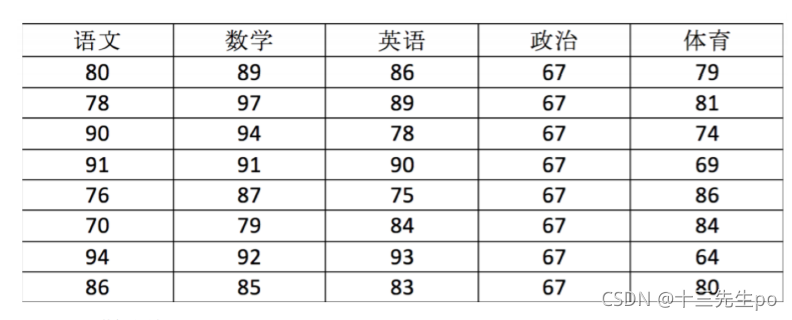
用ndarray进行存储:

简单创建一个array类型数据
import numpy as np
# 创建ndarray
score = np.array([[80, 89, 86, 67, 79],
[78, 97, 89, 67, 81],
[90, 94, 78, 67, 74],
[91, 91, 90, 67, 69],
[76, 87, 75, 67, 86],
[70, 79, 84, 67, 84],
[94, 92, 93, 67, 64],
[86, 85, 83, 67, 80]])
score
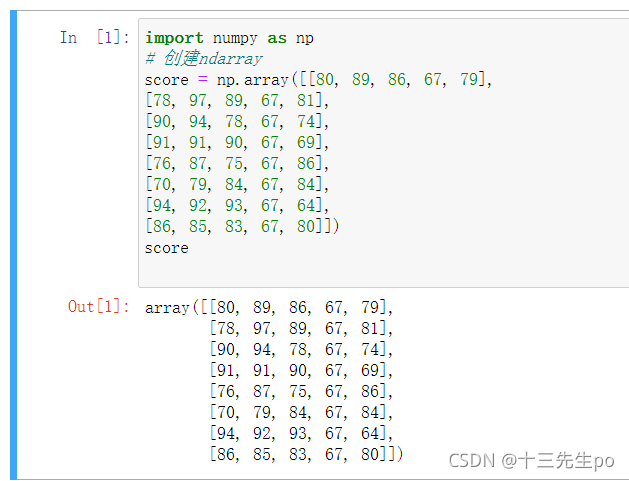
ndarray与Python原生list运算效率对比以及举例代码
在这里我们通过一段带运行来体会到ndarray的好处
import random
import time
import numpy as np
a=[]
for i in range(100000000):
a.append(random.random())
t1 = time.time()
sum1 = sum(a)
t2 = time.time()
b = np.array(a)
t4 = time.time()
sum3 = np.sum(b)
t5 = time.time()
#t2-t1为使用python自带的求和函数消耗的时间,t5-t4为使用numpy求和消耗的时间,结果为:
print(t2-t1,t5-t4)

从中我们看到ndarray的计算速度要快很多,节约了时间。
- 机器学习的最大特点就是大量的数据运算,那么如果没有一个快速的解决方案,那可能现在python也在机器学习领域达不到好的效果。

Numpy专门针对ndarray的操作和运算进行了设计,所以数组的存储效率和输入输出性能远优于Python中的嵌套列表,数组越大,Numpy的优势就越明显。
3 N维数组-ndarray
ndarray的属性
数组属性反映了数组本身固有的信息。
| 属性名字 | 属性解释 |
|---|---|
| ndarray.shape | 数组维度的元组 |
| ndarray.ndim | 数组维数 |
| ndarray.size | 数组中的元素数量 |
| ndarray.itemsize | 一个数组元素的长度(字节) |
| ndarray.dtype | 数组元素的类型 |
ndarray的形状(ndarray.shape)
numpy的array结构和pandas的dataframe结构一样都可以调用查看shape属性
# ndarray的形状
# 创建不同形状的数组
a = np.array([[1,2,3],[4,5,6]])
b = np.array([1,2,3,4])
c = np.array([[[1,2,3],[4,5,6]],[[1,2,3],[4,5,6]]])
a.shape # (2, 3) # 二维数组
b.shape # (4,) # 一维数组
c.shape # (2, 2, 3) # 三维数组

ndarray的类型(ndarray.dtype)
- 注意:若不指定,整数默认int64,小数默认float64
| 名称 | 描述 | 简写 |
|---|---|---|
| np.bool | 用一个字节存储的布尔类型(True或False) | ‘b’ |
| np.int8 | 一个字节大小,-128 至 127 | ‘i’ |
| np.int16 | 整数,-32768 至 32767 | ‘i2’ |
| np.int32 | 整数,-2 31 至 2 32 -1 | ‘i4’ |
| np.int64 | 整数,-2 63 至 2 63 - 1 | ‘i8’ |
| np.uint8 | 无符号整数,0 至 255 | ‘u’ |
| np.uint16 | 无符号整数,0 至 65535 | ‘u2’ |
| np.uint32 | 无符号整数,0 至 2 ** 32 - 1 | ‘u4’ |
| np.uint64 | 无符号整数,0 至 2 ** 64 - 1 | ‘u8’ |
| np.float16 | 半精度浮点数:16位,正负号1位,指数5位,精度10位 | ‘f2’ |
| np.float32 | 单精度浮点数:32位,正负号1位,指数8位,精度23位 | ‘f4’ |
| np.float64 | 双精度浮点数:64位,正负号1位,指数11位,精度52位 | ‘f8’ |
| np.complex64 | 复数,分别用两个32位浮点数表示实部和虚部 | ‘c8’ |
| np.complex128 | 复数,分别用两个64位浮点数表示实部和虚部 | ‘c16’ |
| np.object_ | python对象 | ‘O’ |
| np.string_ | 字符串 | ‘S’ |
| np.unicode_ | unicode类型 | ‘U’ |
举例代码
# ndarray的类型
a = np.array([[1, 2, 3],[4, 5, 6]], dtype=np.float32)
a.dtype # dtype('float32')
arr = np.array(['python', 'tensorflow', 'scikit-learn', 'numpy'], dtype =
np.string_)
arr.dtype # dtype('S12')
3.1基本操作
3.1.1生成数组的方法
1 生成0和1的数组
- empty(shape[, dtype, order]) empty_like(a[, dtype, order, subok])
- eye(N[, M, k, dtype, order])
- identity(n[, dtype])
- ones(shape[, dtype, order])
- ones_like(a[, dtype, order, subok])
- zeros(shape[, dtype, order]) # 常用
- zeros_like(a[, dtype, order, subok])
- full(shape, fill_value[, dtype, order])
- full_like(a, fill_value[, dtype, order, subok])
# 基本操作
# 生成数组的方法
# 生成0和1的数组
zero = np.zeros([3, 4])
zero
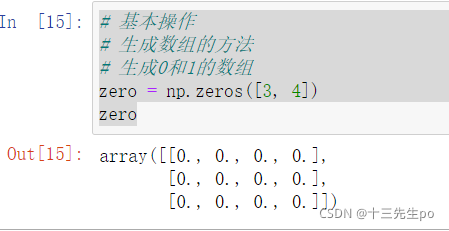
# 基本操作
# 生成数组的方法
# 生成0和1的数组
one = np.ones([3,4])
one
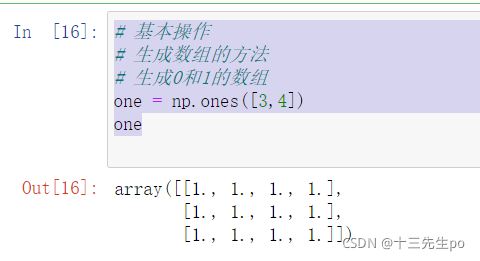
2 从现有数组生成
- array(object[, dtype, copy, order, subok, ndmin])
- asarray(a[, dtype, order])
- asanyarray(a[, dtype, order])
- ascontiguousarray(a[, dtype])
- asmatrix(data[, dtype])
- copy(a[, order])
# 基本操作
# 生成数组的方法
# 2 从现有数组生成
a = np.array([[1,2,3],[4,5,6]])
print(a)
print(a.dtype)
print('============')
# 从现有的数组当中创建
a1 = np.array(a)
print(a1)
print(a1.dtype)
print('============')
# 相当于索引的形式,并没有真正的创建一个新的
a2 = np.asarray(a)
print(a2)
print(a2.dtype)
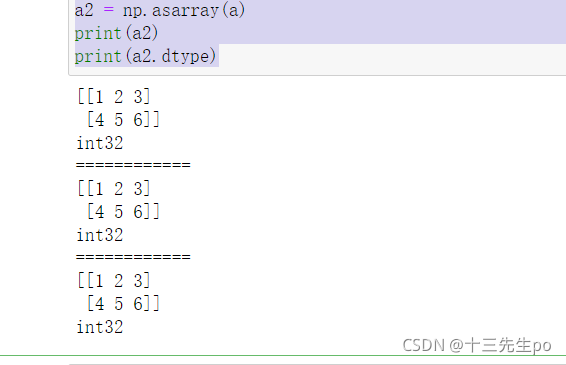
3 生成固定范围的数组
- np.linspace (start, stop, num, endpoint, retstep, dtype)
生成等间隔的序列 - numpy.arange(start,stop, step, dtype)
- numpy.logspace(start,stop, num, endpoint, base, dtype)
start 序列的起始值
stop 序列的终止值,
如果endpoint为true,该值包含于序列中
num 要生成的等间隔样例数量,默认为50
endpoint 序列中是否包含stop值,默认为ture
retstep 如果为true,返回样例,
以及连续数字之间的步长
dtype 输出ndarray的数据类型
# 基本操作
# 生成数组的方法
# 3 生成固定范围的数组
np.linspace(0, 100, 10)

# 基本操作
# 生成数组的方法
# 3 生成固定范围的数组
np.arange(10, 50, 2)

4 生成随机数组
- np.random模块
- 均匀分布
- np.random.rand(d0, d1, …, dn)
返回[0.0,1.0)内的一组均匀分布的数。 - np.random.uniform(low=0.0, high=1.0, size=None)
功能:从一个均匀分布[low,high)中随机采样,注意定义域是左闭右开,即包含low,不
包含high.
参数介绍:
low: 采样下界,float类型,默认值为0;
high: 采样上界,float类型,默认值为1;
size: 输出样本数目,为int或元组(tuple)类型,例如,size=(m,n,k), 则输出mnk个样
本,缺省时输出1个值。
返回值:ndarray类型,其形状和参数size中描述一致。 - np.random.randint(low, high=None, size=None, dtype=‘l’)
从一个均匀分布中随机采样,生成一个整数或N维整数数组,取数范围:若high不为
None时,取[low,high)之间随机整数,否则取值[0,low)之间随机整数。
- np.random.rand(d0, d1, …, dn)
- 均匀分布
# 基本操作
# 生成数组的方法
# 4 生成随机数组
x1 = np.random.uniform(-1, 1, 100000000)
x1

画图看分布状况:
# 基本操作
# 生成数组的方法
# 4 生成随机数组
# 画图看分布状况:
import matplotlib.pyplot as plt
# 生成均匀分布的随机数
x1 = np.random.uniform(-1, 1, 100000000)
# 1 创建画布
plt.figure(figsize=(20,8),dpi=100)
# 2 绘制直方图
plt.hist(x1,1000)
# 3显示
plt.show()

正态分布
- np.random.randn(d0, d1, …, dn)
功能:从标准正态分布中返回一个或多个样本值 - np.random.normal(loc=0.0, scale=1.0, size=None)
loc:float
此概率分布的均值(对应着整个分布的中心centre)
scale:float
此概率分布的标准差(对应于分布的宽度,scale越大越矮胖,scale越小,越瘦高)
size:int or tuple of ints
输出的shape,默认为None,只输出一个值 - np.random.standard_normal(size=None)
返回指定形状的标准正态分布的数组。

# 基本操作
# 生成数组的方法
# 4 生成随机数组
# 正态分布
x2 = np.random.normal(1.75,1,10000000)
x2

- 画图看分布状况
# 基本操作
# 生成数组的方法
# 4 生成随机数组
# 正态分布
# 画图看分布状况
x2 = np.random.normal(1.75,1,10000000)
# 1)创建画布
plt.figure(figsize=(20, 10), dpi=100)
# 2)绘制直方图
plt.hist(x2, 1000)
# 3)显示图像
plt.show()

案例:随机生成8只股票2周的交易日涨幅数据
8只股票,两周(10天)的涨跌幅数据,如何获取?
- 两周的交易日数量为:2 X 5 =10
- 随机生成涨跌幅在某个正态分布内,比如均值0,方差1
# 基本操作
# 生成数组的方法
# 4 生成随机数组
# 案例:随机生成8只股票2周的交易日涨幅数据
st_change = np.random.normal(0,1,(8,10))
st_change

3.1.2 数组值的改变
# 基本操作
# 生成数组的方法
# 生成0和1的数组
one = np.ones([3,4])
one[1] = 3
one
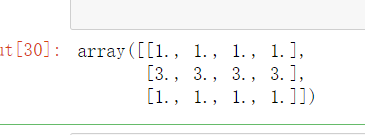
# 基本操作
# 生成数组的方法
# 2 从现有数组生成
a = np.array([[1,2,3],[4,5,6]])
a[1] = 4
print(a)
print(a.dtype)
print('============')
# 从现有的数组当中创建
a1 = np.array(a)
print(a1)
print(a1.dtype)
print('============')
# 相当于索引的形式,并没有真正的创建一个新的
a2 = np.asarray(a)
print(a2)
print(a2.dtype)
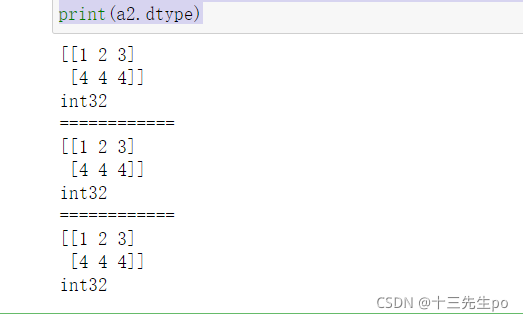
3.1.3 数组的索引、切片
目标代码
st_change = np.random.normal(0,1,(8,10))
st_change
- 获取第一个股票的前3个交易日的涨跌幅数据
# 数组的索引、切片
# 获取第一个股票的前3个交易日的涨跌幅数据
st_change = np.random.normal(0,1,(8,10))
# st_change
st_change[0,0:3]

一维、二维、三维的数组如何索引?
# 数组的索引、切片
# 一维、二维、三维的数组如何索引?
# 三维,一维
a1 = np.array([1,2,3,4,5,67,8])
a3 = np.array([ [[1,2,3],[4,5,6]], [[12,3,34],[5,6,7]]])
print(a1.shape)
print(a3.shape)
print('==================')
print(a1[3])
print(a3[0,1])
print(a3[0,1,1])

3.1.4 形状修改
需求:让刚才的股票行、日期列反过来,变成日期行,股票列
st_change = np.random.normal(0,1,(8,10))
st_change
ndarray.reshape(shape[, order]) Returns an array containing the same data with a new shape
# 在转换形状的时候,一定要注意数组的元素匹配
stock_change.reshape([10, 8]) # 只是将形状进行了修改,但并没有将行列进行转换
stock_change.reshape([-1, 8]) # 不用计算行,根据列自动计算默认写-1

ndarray.T 数组的转置
将数组的行、列进行互换
st_change.T # 创建新的改变结构的矩阵

ndarray.resize(new_shape[, refcheck]) Change shape and size of array in-place.
st_change.resize([10, 8]) # 改变形状并且创建新的数组
st_change

3.1.5 类型修改
ndarray.astype(type)
st_change.astype(np.int32)

ndarray.tostring([order])或者ndarray.tobytes([order])
Construct Python bytes containing the raw data bytes in the array
转换成bytes
st_change.tostring()

- 拓展:如果遇到
IOPub data rate exceeded.
The notebook server will temporarily stop sending output
to the client in order to avoid crashing it.
To change this limit, set the config variable
`--NotebookApp.iopub_data_rate_limit`.
这个问题是在jupyer当中对输出的字节数有限制,需要去修改配置文件
创建配置文件
jupyter notebook --generate-config
vi ~/.jupyter/jupyter_notebook_config.py
取消注释,多增加
## (bytes/sec) Maximum rate at which messages can be sent on iopub before they
# are limited.
c.NotebookApp.iopub_data_rate_limit = 10000000
但是不建议这样去修改,jupyter输出太大会崩溃
3.1.6 数组的去重
- ndarray.unique
# 数组的去重
temp = np.array([[1, 2, 3, 4],[3, 4, 5, 6]])
np.unique(temp)

3.1.7 小结
- 创建数组
- 均匀
- 随机(正态分布)
- 正态分布
- 数组索引
- 数组形状改变
- 数组类型
- reshape
- resize
- 数组转换
- T
- tostring
- unique
4 ndarray运算
应用:操作符合某一条件的数据
1 逻辑运算
# ndarray运算
# 逻辑运算
# 生成8只股票10个交易日的涨跌幅数据
st_change = np.random.normal(0,1,(8,10))
# st_change
# 逻辑判断, 如果涨跌幅大于0.5就标记为True 否则为False
st_change > 0.5
# BOOL赋值, 将满足条件的设置为指定的值-布尔索引
st_change[st_change > 0.5] = 1
st_change

2 通用判断函数
- np.all()
# ndarray运算
# 通用判断函数
# 判断stock_change[0:2, 0:5]是否全是上涨的 只要有一个是Flase 就返回false
np.all(st_change[0:2,0:5] > 0)

- np.any()
# ndarray运算
# 通用判断函数
# 判断前5只股票这段期间是否有上涨的 要有一个是Trye 就返回true
np.all(st_change[0:5,:] > 0) # 写法1
np.all(st_change[0:5] > 0) # 写法2

3 np.where(三元运算符)
通过使用np.where能够进行更加复杂的运算
- np.where()
# ndarray运算
# np.where(三元运算符)
# 判断前四个股票前四天的涨跌幅 大于0的置为1,否则为0
temp = st_change[:4,:4]
np.where(temp > 0,1,0)

- 复合逻辑需要结合np.logical_and和np.logical_or使用
# ndarray运算
# np.where(三元运算符)
# 复合逻辑需要结合np.logical_and和np.logical_or使用
# 判断前四个股票前四天的涨跌幅 大于0.5并且小于1的,换为1,否则为0
np.where(np.logical_and(temp>0.5,temp<1),1,0)
# 判断前四个股票前四天的涨跌幅 大于0.5或者小于-0.5的,换为1,否则为0
np.where(np.logical_or(temp>0.5,temp<-0.5),1,0)

4 统计运算
想要知道涨幅或者跌幅最大的数据
4.4.1 统计指标
在数据挖掘/机器学习领域,统计指标的值也是我们分析问题的一种方式。常用的指标如下:
- min(a[, axis, out, keepdims])
-Return the minimum of an array or minimum along an axis. - max(a[, axis, out, keepdims])
-Return the maximum of an array or maximum along an axis. - median(a[, axis, out, overwrite_input, keepdims])
-Compute the median along the specified axis. - mean(a[, axis, dtype, out, keepdims])
-Compute the arithmetic mean along the specified axis. - std(a[, axis, dtype, out, ddof, keepdims])
-Compute the standard deviation along the specified axis. - var(a[, axis, dtype, out, ddof, keepdims])
-Compute the variance along the specified axis.
4.4.2 股票涨跌幅统计运算
进行统计的时候,axis 轴的取值并不一定,Numpy中不同的API轴的值都不一样,在这里,axis 0代表列, axis 1代表行去进行统计
# ndarray运算
# 4 统计运算
# 股票涨跌幅统计运算
temp1 = st_change[:4,:4]
temp1
# axis 轴的取值并不一定,Numpy中不同的API轴的值都不一样,在这里,axis 0代表列, axis 1代表行去进行统计
# 接下来对于这4只股票的4天数据,进行一些统计运算
# 指定行 去统计
print('前四只股票前四天的最大涨幅{}'.format(np.max(temp,axis=1)))
# 使用min, std, mean
print('前四只股票前四天的最大跌幅{}'.format(np.min(temp,axis=1)))
print('前四只股票前四天的波动程度{}'.format(np.std(temp,axis=1)))
print('前四只股票前四天的平均涨跌幅{}'.format(np.mean(temp,axis=1)))

- 需要统计出哪一只股票在某个交易日的涨幅最大或者最小
- np.argmax(temp, axis=)
- np.argmin(temp, axis=)
# ndarray运算
# 4 统计运算
# 股票涨跌幅统计运算
# 需要统计出哪一只股票在某个交易日的涨幅最大或者最小
print("前四只股票前四天内涨幅最大{}".format(np.argmax(temp, axis=1)))
print("前四天一天内涨幅最大的股票{}".format(np.argmax(temp, axis=0)))
temp

4.4.3 sum()求和、np.bincount(xx)分类频率计数
适用于一维数组的所有值相加
- sum()求和
目标数组
# 降2维后方差百分比
pca2.explained_variance_ratio_
# pca2.explained_variance_ratio_.sum() # 聚类后只保留了原信息的约64%

进行求和
# 降2维后方差百分比
pca2.explained_variance_ratio_
pca2.explained_variance_ratio_.sum() # 聚类后只保留了原信息的约64%

- np.bincount(xx) 分类频率计数
可以认为是一维数组的分类聚合
目标数据,有61979条
kmodel.labels_,kmodel.labels_.shape

进行求和
np.bincount(kmodel.labels_)

加起来的数量也没有变化
np.bincount(kmodel.labels_).sum()

5 数组间的运算
1 应用背景

[[80, 86],
[82, 80],
[85, 78],
[90, 90],
[86, 82],
[82, 90],
[78, 80],
[92, 94]]
2 数组与数的运算
# 数组与数的运算
arr = np.array([[1, 2, 3, 2, 1, 4], [5, 6, 1, 2, 3, 1]])
# arr
arr + 1
arr / 2
# 可以对比python列表的运算,看出区别
a = [1,2,3,4,5]
a * 3

但是下面这个数组直接运算是不行的
# 数组与数的运算
# 错误示范
arr1 = np.array([[1, 2, 3, 2, 1, 4], [5, 6, 1, 2, 3, 1]])
arr2 = np.array([[1, 2, 3, 4], [3, 4, 5, 6]])
arr1 + arr2

报错:
ValueError: operands could not be broadcast together with shapes (2,6) (2,4)
3 广播机制
执行 broadcast 的前提在于,两个 ndarray 执行的是 element-wise的运算,Broadcast机制的功能是为了方便不同形状的ndarray(numpy库的核心数据结构)进行数学运算。
当操作两个数组时,numpy会逐个比较它们的shape(构成的元组tuple),只有在下述情况下,两个数组才能够进行数组与数组的运算。
- 维度相等
- shape(其中相对应的一个地方为1)
广播机制如果简单理解的话,就是看一个数组能否扩展为另一个数组的结构,以便他们之间能进行运算
- 例如,一个三行两列的数组,和一个一行2列的数组,或一个单值数组,后两个都可以广播扩展为三行两列,就可以进行计算
上面的讲解就一个理解为
- 1可以变成任意多个值
- 一,或者相同个数,都可以广播
以下例子都可以进行运算
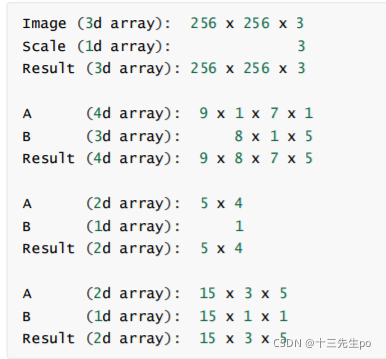
如果是下面这样,则不匹配:
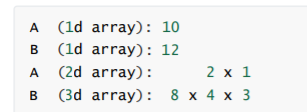
- 10和12不相同,不能运算
- 2和4不相同,不能运算,如果4变成2或者1(合理即可)的话就能运算了
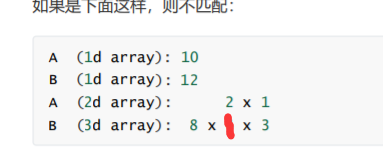

思考:下面两个ndarray是否能够进行运算?
arr1 = np.array([[1, 2, 3, 2, 1, 4], [5, 6, 1, 2, 3, 1]])
arr2 = np.array([[1], [3]])
答案是可以运算的
arr1 = np.array([[1, 2, 3, 2, 1, 4], [5, 6, 1, 2, 3, 1]])
arr2 = np.array([[1], [3]])
print(arr1.shape) # (2, 6)
print(arr2.shape) # (2, 1)
arr1 + arr2 # 可以运算

4 矩阵运算

思考:如何能够直接得出每个学生的成绩?
1 什么是矩阵
矩阵,英文matrix,和array的区别矩阵必须是2维的,但是array可以是多维的。
- np.mat()
将数组转换成矩阵类型
# 矩阵运算
# 将数组转换成矩阵类型
a = np.array([[80, 86],
[82, 80],
[85, 78],
[90, 90],
[86, 82],
[82, 90],
[78, 80],
[92, 94]])
b = np.array([[0.7], [0.3]])
np.mat(a)

2 矩阵乘法运算
矩阵乘法的两个关键:
- 形状改变
- 运算规则
形状改变:

必须符合上面的式子,否则运算出错。
运算规则:

- 矩阵乘法api:
- np.matmul
- np.dot
# 矩阵运算
# 2 矩阵乘法运算
a = np.array([[80, 86],[82, 80],[85, 78],[90, 90],[86, 82],[82, 90],[78, 80],[92, 94]])
b = np.array([[0.7], [0.3]])
np.matmul(a, b)
np.dot(a,b)

3 矩阵应用场景
大部分机器学习算法需要用到
6 合并、分割
合并、分割的用处:实现数据的切分和合并,将数据进行切分合并处理
6.1 合并
- numpy.concatenate((a1, a2, …), axis=0)
- numpy.hstack(tup) Stack arrays in sequence horizontally (column wise).
- numpy.vstack(tup) Stack arrays in sequence vertically (row wise).
# 合并
a = np.array([[1, 2], [3, 4]])
b = np.array([[5, 6]])
np.concatenate((a, b), axis=0)
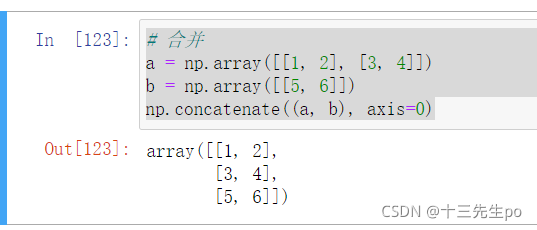
# 合并
np.concatenate((a, b.T), axis=1)

# 合并
a = np.array((1,2,3))
b = np.array((2,3,4))
np.hstack((a,b))
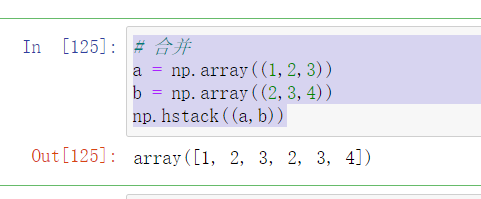
# 合并
a = np.array([[1],[2],[3]])
b = np.array([[2],[3],[4]])
np.hstack((a,b))

# 合并
a = np.array([1, 2, 3])
b = np.array([2, 3, 4])
np.vstack((a,b))
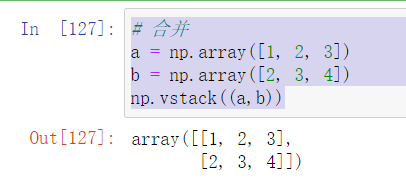
a = np.array([[1], [2], [3]])
b = np.array([[2], [3], [4]])
np.vstack((a, b))

比如我们将两部分股票的数据拼接在一起:
# 比如我们将两部分股票的数据拼接在一起:
a = st_change[:2,0:4]
b = st_change[4:6,0:4]
a
b
# axis=1时候,按照数组的列方向拼接在一起
# axis=0时候,按照数组的行方向拼接在一起
print(np.concatenate([a,b],axis=1))
print(np.hstack([a,b]))
print('============================')
print(np.concatenate([a,b],axis=0))
print(np.vstack([a,b]))
6.2 分割
- numpy.split(ary, indices_or_sections, axis=0)
Split an array into multiple sub-arrays.
# 2 分割
# 按间隔分
x = np.arange(9)
np.split(x,3)

# 2 分割
# 按指定位置分
x = np.arange(8.0)
np.split(x,[3,5,6,10])

7 IO操作与数据
7.1 问题
大多数数据并不是我们自己构造的,而是存在文件当中,需要我们用工具获取。
但是Numpy其实并不适合用来读取和处理数据,因此我们这里了解相关API,以及Numpy不方便的地方即可。
7.2 Numpy读取
- genfromtxt(fname[, dtype, comments, …])
Load data from a text file, with missing values handled as specified.

# 读取数据
test = np.genfromtxt("test.csv", delimiter=',')
7.3 如何处理缺失值
1 什么是缺失值
什么时候numpy中会出现nan:当我们读取本地的文件为float的时候,如果有缺失(或者为None),就会出现nan
2 缺失值处理
那么,在一组数据中单纯的把nan替换为0,合适么?会带来什么样的影响?
比如,全部替换为0后,替换之前的平均值如果大于0,替换之后的均值肯定会变小,所以更一般的方式是把缺失的数值替换为均值(中值)或者是直接删除有缺失值的一行
所以:
- 如何计算一组数据的中值或者是均值
- 如何删除有缺失数据的那一行(列)在pandas中介绍